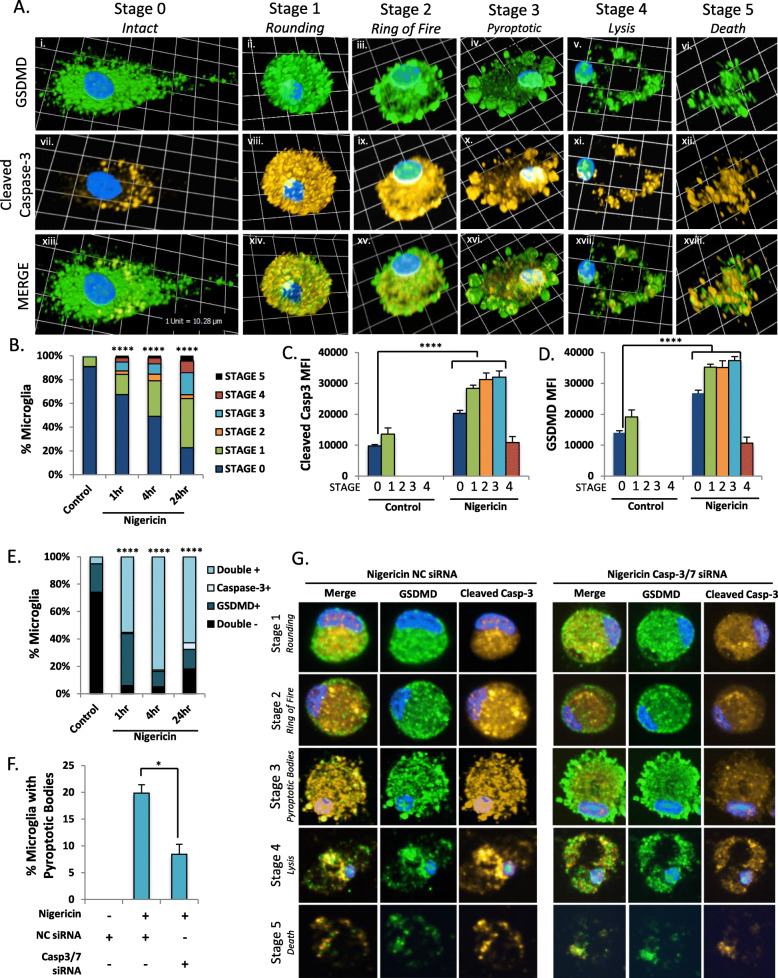Fig. 5.
Activated caspase-3 mediates pyroptotic body formation and cell death. Microglia were exposed to nigericin (5.0 μM, 4 h), fixed, and immunolabelled for GSDMD (Ai–vi, green) and cleaved caspase-3 p17/p19 (Avii–xiii, amber), merge shown in (Axiii–xviii) and visualized by confocal microscopy. Based upon morphological and molecular characteristics, five stages of pyroptosis were defined including Stage 0: “Intact” (adherent cell with elongated processes, baseline GSDMD expression); Stage 1: “Rounding” (rounded cell, loss of processes, increased GSDMD expression throughout the cell); Stage 2: “Ring-of-fire” (translocation of GSDMD to the cell membrane); Stage 3: “Pyroptotic bodies” (formation of GSDMD+ membrane blebs); Stage 4: “Lysis” (rupture of the cell, nucleus still intact), and finally Stage 5: “Ghost cells” (nucleus disintegrated, residual GSDMD+ cell debris). Images shown for each stage are representative three-dimensional z-stacks incorporating 15 XY planes over a vertical distance of 4–6 μm. (B) The proportion of cells at each stage was quantified at 0, 1, 4, and 24 h post-exposure to nigericin, with a minimum of n = 60 unexposed microglia and n = 100 microglia at each time point post-exposure. Time course data represent the proportion of cells at each stage for a representative sample and have been replicated in microglia derived from two independent human donors. Distribution of the cells across the stages was assessed using a Chi-squared test. (C, D) Microglia from (A) were classified according to the stage of pyroptosis and cleaved caspase-3 (C) or total GSDMD (D) MFI was assessed for each stage of pyroptosis at 4 h post exposure to nigericin. All time course data were independently replicated using microglia derived in 2–3 human donors. To determine co-localization of caspase-3 and GSDMD, human microglia were exposed to nigericin (5 μM, 1, 4, or 24 h), fixed, immunolabelled for cleaved caspase-3 and GSDMD (E). Mean fluorescence intensity (MFI) of each protein was assessed. Each cell was categorized as single-immunopositive, double-immunopositive, or double-immunonegative for GSDMD and cleaved caspase-3 using a threshold of 3X background fluorescence. A minimum of n = 40 microglia were classified per time point. Distribution of cells within each of the four categories was significantly different from control using Chi-square test (****p < 0.0001). (F–G) Microglia were transfected with either universal non-coding siRNA (NC siRNA) or a cocktail of different siRNAs targeting caspases-3 and -7 (Casp-3/7 siRNA) prior to nigericin exposure (5 μM, 24 h). Cells were fixed, immunolabelled for GSDMD (green) and cleaved caspase-3 (amber), and the proportion of cells at each stage was quantified. A minimum of n = 100 cells were quantified in each condition and results recapitulated in two independent human donors

